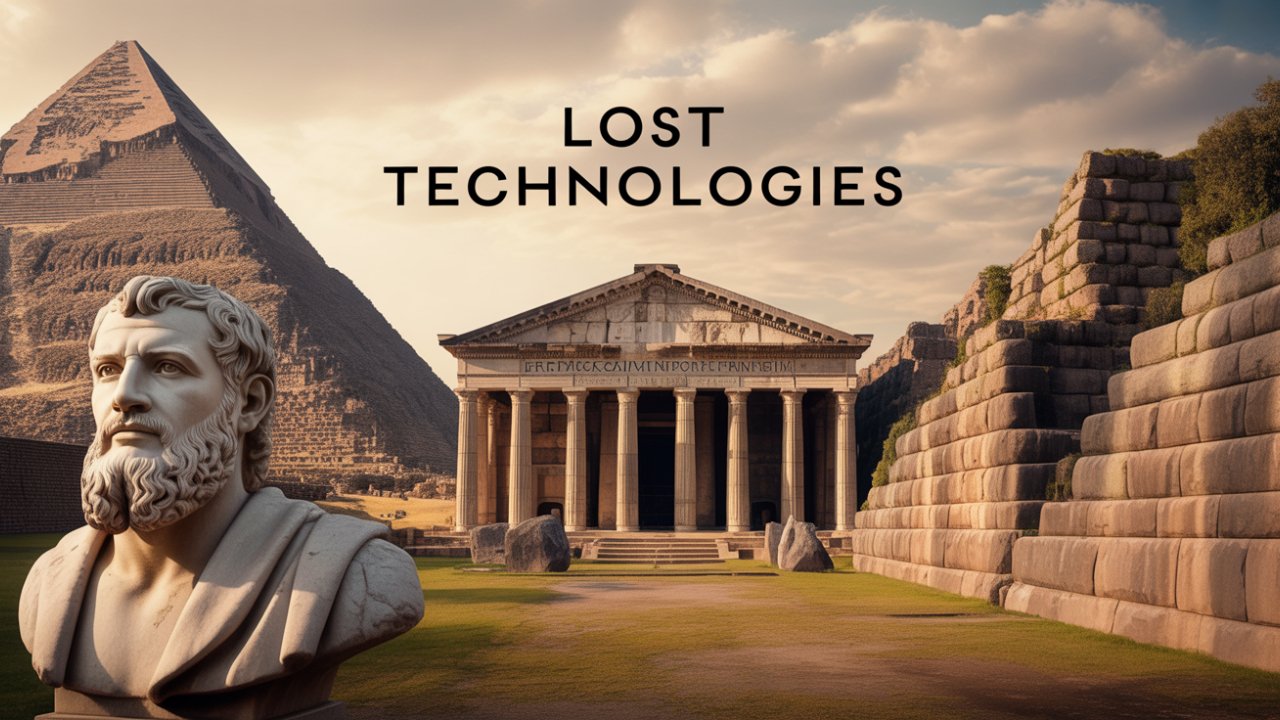We live in an age of technological wonders. We build skyscrapers that touch the clouds, talk to anyone on the planet instantly, and send robots to explore other worlds. But for all our modern skill, there’s a profound mystery buried in our past. We can build bigger and faster, but can we still build to last?
What if I told you that we’re still reverse-engineering a concrete recipe from 2,000 years ago? A Roman concrete used in marine environments that not only endures but can actually heal itself and grow stronger over time. We have colossal cranes and advanced machinery, yet we still debate how ancient Egyptians quarried, moved, and lifted millions of multi-ton stone blocks with breathtaking precision. What did these ancient civilizations know that we’ve since forgotten?
Today, we’re going back in time. We aren’t just visiting ruins; we’re stepping into the minds of the master engineers of antiquity. Our mission is to decode the lost technologies of the Egyptians, the Incas, and the Romans. This isn’t a story about magic or aliens. It’s a story of human ingenuity a different kind of genius, born from deep observation, relentless trial and error, and an intimate understanding of the natural world. We’ll follow a path of mystery, investigation, and revelation to uncover the engineering secrets that allowed these ancient peoples to build for eternity.
Our journey begins on the sun-scorched Giza plateau, in the shadow of the last surviving wonder of the ancient world: the Great Pyramid of Khufu. It’s a monument on an almost unbelievable scale. Originally standing at 146.6 meters, or about 481 feet, it was the tallest man-made structure on Earth for nearly 4,000 years. It’s built from an estimated 2.3 million stone blocks, each weighing an average of 2.5 tons the same as a large SUV. Some of the granite blocks, used for the king’s chamber deep inside, weigh as much as 80 tons.
And that’s the first great mystery. How? How did a Bronze Age culture, with tools mostly limited to copper, wood, and rope, pull this off? How did they quarry these massive stones, transport them, and then raise them to staggering heights with a precision that would challenge modern builders? The pyramid’s base is astonishingly level, and its sides are aligned to the cardinal directions almost perfectly.
For centuries, the sheer scale of the project has fueled speculation about forgotten technologies or even help from extraterrestrial visitors. But while these ideas are fun to imagine, they sell the real genius of the Egyptian people short. The truth that archaeologists are piecing together is arguably even more impressive. It’s a story of human brilliance, organization, and a mastery of physics on an epic scale.
The most widely accepted theory for lifting the stones has long been the ramp. The idea is simple: workers would have built enormous ramps and then hauled the stone blocks up them on wooden sledges, likely lubricating the path with water to reduce friction. But a single, straight ramp to the top of the pyramid would have been a monumental project in itself, stretching for over a mile. This has led to other theories, like a ramp that zig-zags up one face, or a spiral ramp that corkscrews around the outside.
The debate is still very much alive. But a 2018 discovery in an ancient quarry at Hatnub gave us a fascinating clue. Archaeologists unearthed a ramp system from the same period as the Great Pyramid. It was much steeper than anyone thought possible and was flanked by staircases with postholes. This suggests a sophisticated system where ropes could be looped around posts, allowing teams on the sides to use a pulley-like mechanism to help haul immense weights up the steep incline. This doesn’t prove it’s how they built the Great Pyramid, but it shows their ramp technology was far more advanced than we knew.
But how did they place the stones so precisely? The Greek historian Herodotus, writing nearly two thousand years after Khufu, described a system of levers made from short wooden logs to hoist blocks from one level to the next. While his account is second-hand and debated by historians, it points to the clever use of simple machines.
And who were the people doing all this work? Forget the Hollywood image of slaves being brutally driven by cruel overseers. Archaeological evidence has completely overturned that myth. Excavations have revealed the tombs of the builders honored graves for skilled workers, buried with tools and food for the afterlife. Archaeologists like Mark Lehner have uncovered an entire city built for the workers, complete with bakeries, breweries, and medical facilities that show evidence of doctors setting broken bones. This was not a slave army. It was a highly organized and well-fed national project, made up of laborers who likely took great pride in building a monument for their king.
So what was the Egyptians’ “lost technology”? It wasn’t one single device. It was something far more impressive: an unparalleled mastery of project management. Their true technology was a system the organizational genius to mobilize and manage a massive, skilled workforce for decades, and the engineering genius to scale up simple machines to a degree the world had never seen. The pyramid itself is the ultimate proof, a monument built not by aliens, but by the coordinated power of human hands and minds.
Just as the Egyptians mastered stone on the flat desert plains, another civilization halfway across the world was mastering it in a far more challenging environment. We travel now from the banks of the Nile to the dizzying heights of the Andes, to a place where stone seems to flow like water. We’re going to uncover the secrets of the Inca.
Perched at nearly 8,000 feet in the Andes, Machu Picchu is a breathtaking citadel of terraces and temples, seamlessly woven into a hostile, vertical landscape. It’s the most famous legacy of the Inca Empire, a civilization that built a sophisticated society stretching 2,500 miles along the spine of South America.
The mystery here is not just that it was built, but how. The Incas had no iron tools, no wheels for transport, and no written language to pass down blueprints. Yet they created structures using a technique called ashlar masonry, where massive, irregular stones are shaped to fit together so perfectly you can’t slip a knife blade between them. These aren’t simple cubes; they’re complex, polygonal blocks, some with more than a dozen corners, all interlocking like a 3D jigsaw puzzle.
The investigation starts not with the walls, but with the ground beneath them. Peru is part of the Pacific Ring of Fire earthquakes are a constant threat. A normal, mortar-bound wall would crack and crumble. The Spanish conquistadors learned this the hard way; their churches, built on the foundations of Inca temples, were repeatedly damaged or destroyed by earthquakes, while the original Inca walls often stood firm.
Here’s the first revelation: Inca walls were designed to move. They’re famous for their “dancing stones.” During an earthquake, the tight-fitting but mortar-free stones can shift and vibrate, dissipating the seismic energy. When the shaking stops, they settle back into place. This incredible flexibility is the secret to their survival. The Incas didn’t fight the earth; they engineered a way to roll with its punches.
But how did they shape hard granite with such accuracy? The most accepted theory is a painstakingly slow process. A mason would place a new, unfinished block on top of a finished one. They would then meticulously trace the contours of the lower stone onto the upper one and, using harder hammerstones, slowly chip and grind it away until it was a perfect match. It’s a testament to unbelievable patience and craftsmanship.
The logistics were just as staggering. How did they move stones weighing over 50 tons up the steep mountain slopes without the wheel or strong draft animals? The answer, again, is organized human power. Using thousands of laborers, they would have slowly dragged the blocks with thick ropes, laying down paths of gravel and wet clay to reduce friction. At the building site, they built long earthen ramps to bring the stones up, then used bronze crowbars and levers to maneuver them into their final position.
And the Inca genius didn’t stop at what’s visible. It’s estimated that as much as 60% of the construction at Machu Picchu is underground. Before laying a single wall, engineers built deep foundations and a complex drainage system to channel away torrential rains, preventing erosion and keeping the entire city stable. They were masters of water management, building fountains and canals that still work today.
The revelation of Inca engineering is that it was a holistic, environmental science. Their “lost technology” was a system that combined seismic-resistant design, meticulous stonework, and brilliant civil engineering. They didn’t just build on the mountain; they made the mountain part of the city. They understood their environment its dangers and its resources with an intimacy we are only now beginning to appreciate.
The ingenuity of the Incas is mind-boggling. Before we travel to our final destination to uncover a technology that actually gets stronger with time if you’re finding this journey as fascinating as I am, make sure to hit that subscribe button and ring the bell so you don’t miss our future explorations. Now, let’s head to the heart of the Roman Empire.
From the mountains of Peru, we now journey to the sprawling empire that defined the Western world. While the Egyptians and Incas were masters of shaping natural stone, the Romans pioneered a revolutionary artificial stone. It was a material that let them build on an unprecedented scale, create new architectural forms, and even build in the sea. They invented a substance so durable, its secrets are still inspiring scientists today. We’re talking about Roman concrete.
(Section 3: The Romans – Architects of Immortal Concrete)
Walk through Rome and you’re surrounded by engineering marvels. The Colosseum still stands. The aqueducts still march across the landscape. But the ultimate expression of Roman concrete’s genius is the Pantheon. Its magnificent dome, over 142 feet across, remains the largest unreinforced concrete dome in the world. It has survived earthquakes, invasions, and nearly two millennia of history.
By contrast, many modern concrete structures have a designed lifespan of 50 to 100 years, though critical infrastructure is often built to last longer. Our steel-reinforced concrete is vulnerable, especially to saltwater, which corrodes the steel and causes the structure to crumble. Yet, ancient Roman piers and breakwaters submerged in the Mediterranean for 2,000 years are often still intact.
So, what was their secret? The investigation into opus caementicium, as they called it, reveals a masterpiece of chemistry. The key was a special volcanic ash they called pozzolana. The ancient writer Pliny the Elder marveled that this ash, when mixed with lime, would become “a single stone mass, impregnable to the waves and every day stronger.”
For years, scientists thought this ash was the whole secret. But it wasn’t the full story. Using advanced technology, researchers examined the concrete at a microscopic level and focused on tiny, white chunks of lime, called “lime clasts,” which were once dismissed as signs of sloppy mixing. But as Professor Admir Masic of MIT asked, why would the Romans, who were so meticulous, be so careless with their star material?
This question led to a groundbreaking revelation: the lime clasts weren’t a mistake; they were the secret ingredient for self-healing. The research suggests the Romans used “hot mixing,” adding quicklime directly to the mix. This generated intense heat and created these brittle, reactive lime clasts.
Here’s where the magic happens. When a tiny crack forms in the concrete, it often runs through one of these lime clasts. Water seeps in and reacts with the quicklime inside. This creates a new calcium solution that flows into the crack, where it rapidly recrystallizes, sealing the damage from within. In lab tests replicating the process, cracks in Roman-style concrete healed completely within weeks.
In saltwater, the process is even more remarkable. Seawater not only triggers this healing but also reacts with the volcanic ash to grow rare, interlocking minerals that fill the voids, making the concrete even stronger. The very element that destroys our concrete is what allows Roman marine concrete to regenerate. It’s a material that can get stronger with age and adversity.
The lost technology of the Romans was a profound, practical understanding of chemistry. It was knowledge born from centuries of trial and error, which allowed them to build an immortal empire. While some pozzolanic building traditions continued after the empire fell, the deep scientific understanding behind this self-healing process was lost, waiting nearly two millennia to be fully decoded.
We started by asking: What did these ancient civilizations know that we’ve lost? From the deserts of Egypt to the mountains of Peru and the heart of Rome, we’ve found the answer is as monumental as the structures themselves.
We saw the Egyptians, whose real technology was an unparalleled command of logistics and project management, organizing an entire society to build for their gods.
We saw the Incas, who developed a sublime and harmonious relationship with a violent earth. Their technology was an elegant dance between stone and seismic force.
And we saw the Romans, who used empirical chemistry to create a material that could heal itself and defy the ages.
The thread connecting all these “lost” technologies is a fundamentally different philosophy. These ancient masters worked with the world around them. They observed natural processes, respected environmental forces, and used local materials to create solutions in harmony with their surroundings.
Today, as we face our own challenges, we are looking back to these ancient masters for inspiration. Scientists are actively working to reverse-engineer Roman concrete to create modern, self-healing materials. Architects look to the earthquake-proof designs of the Incas. The enduring stones of the pyramids, the dancing walls of Machu Picchu, and the immortal dome of the Pantheon are more than just relics. They are a message, a challenge from our ancestors, reminding us that our most powerful technology has always been, and will always be, human ingenuity.
What do you think is the most incredible feat of ancient engineering? The Pyramids, Machu Picchu, or Roman concrete? Let us know in the comments below. And if there’s another ancient mystery you want us to decode, we’d love to hear about it. Thanks for watching.





